Fiber optic lighting delivers exceptional clarity for scientific photography through precise light control. You’ll capture intricate details while minimizing glare and unwanted reflections. The flexible cables allow you to position lights exactly where needed, enhancing contrast and revealing delicate features. Unlike traditional lighting, fiber optics won’t damage heat-sensitive specimens during long exposures. Their versatility makes them ideal across geology, forensics, materials science, and biological research. Discover how these specialized lights can transform your scientific documentation.
Superior Detail Resolution Through Precision Light Delivery
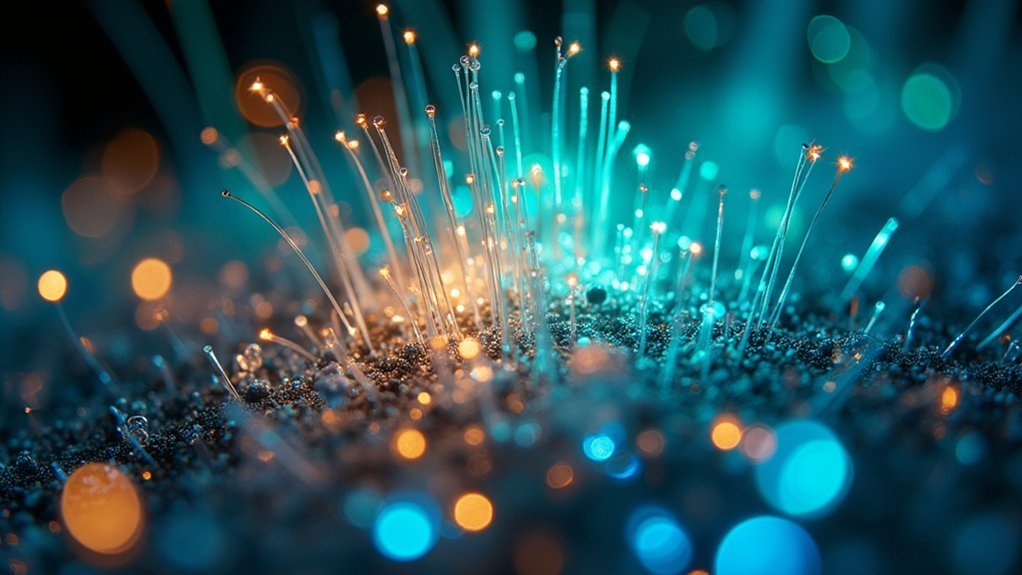
When photographing intricate subjects, fiber optic lights deliver exceptional clarity that standard lighting simply can’t match.
You’ll notice immediately how these systems provide highly directed illumination, giving you precise control over light paths that reveal fine details other lighting obscures.
Fiber optic lighting considerably reduces glare and unwanted reflections that typically mask delicate features in your specimens.
The flexible cables allow you to position light sources exactly where needed, illuminating microscopic subjects from multiple angles simultaneously.
This strategic positioning enhances texture and surface detail in your high-resolution photographs.
You can also fine-tune both intensity and color temperature to create ideal conditions for your specific subject.
This customization guarantees you’ll capture subtle variations that might otherwise go unnoticed with conventional lighting methods.
Minimizing Heat and Light Damage to Sensitive Specimens
While capturing detailed images of delicate specimens, you’ll find fiber optic lighting indispensable for preventing damage that conventional light sources often cause. Fiber optics generate minimal heat, protecting temperature-sensitive materials from thermal degradation during extended photography sessions.
You’ll also appreciate the precise control over light intensity and focus that fiber optics provide, preventing overexposure and limiting illumination to only necessary areas.
| Protection Feature | Fiber Optic Benefit |
|---|---|
| Thermal Protection | Minimal heat generation |
| Exposure Control | Adjustable intensity settings |
| Targeted Illumination | Focused light delivery |
| Color Preservation | Customizable color temperature |
Customizable Light Positioning for Optimal Contrast
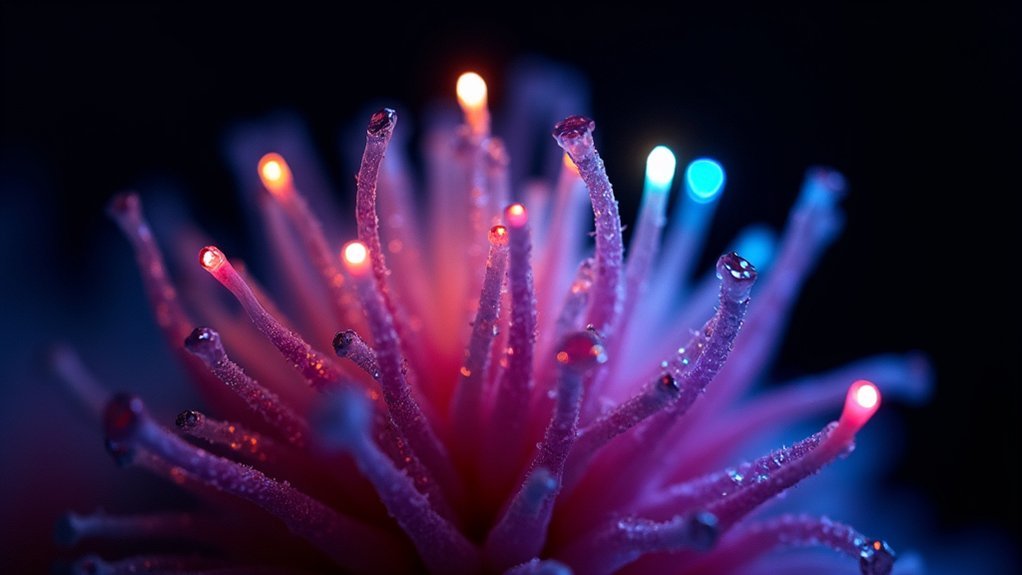
The precise positioning of your fiber optic lights can dramatically transform ordinary specimen photography into stunning, detailed captures. By manipulating these flexible cables, you’ll gain unparalleled control over illumination angles, allowing you to highlight specific features while minimizing distracting shadows.
Unlike traditional lighting setups, you can easily maneuver fiber optic lights into tight spaces and around complex subjects. This flexibility lets you direct light exactly where it’s needed, revealing fine textures and surface details that might otherwise remain hidden.
You’re free to experiment with various configurations—try positioning lights at different distances and angles to enhance contrast and bring out subtle details.
This customizable approach means you’ll capture sharper, more defined images that showcase your specimens’ intricate features with remarkable clarity.
Technical Advantages for Macro and Microphotography
Beyond positioning flexibility, fiber optic lighting systems offer remarkable technical benefits that elevate macro and microphotography to professional levels.
You’ll appreciate their precise, controlled illumination that reduces shadows and provides even lighting across your subject—critical when capturing minute details.
When working with delicate specimens, fiber optic lights are invaluable because they generate minimal heat, preventing damage during extended shooting sessions.
You can easily adjust light intensity and color temperature to match your specific requirements, ensuring ideal exposure for various subjects.
The interchangeable fiber optic guides allow you to adapt your lighting setup for different angles and distances.
Their compact, flexible design fits into tight spaces, making them perfect for complex scientific photography scenarios where traditional lighting systems would be impractical or impossible to position effectively.
Cost-Effective Alternatives to Professional Lighting Systems
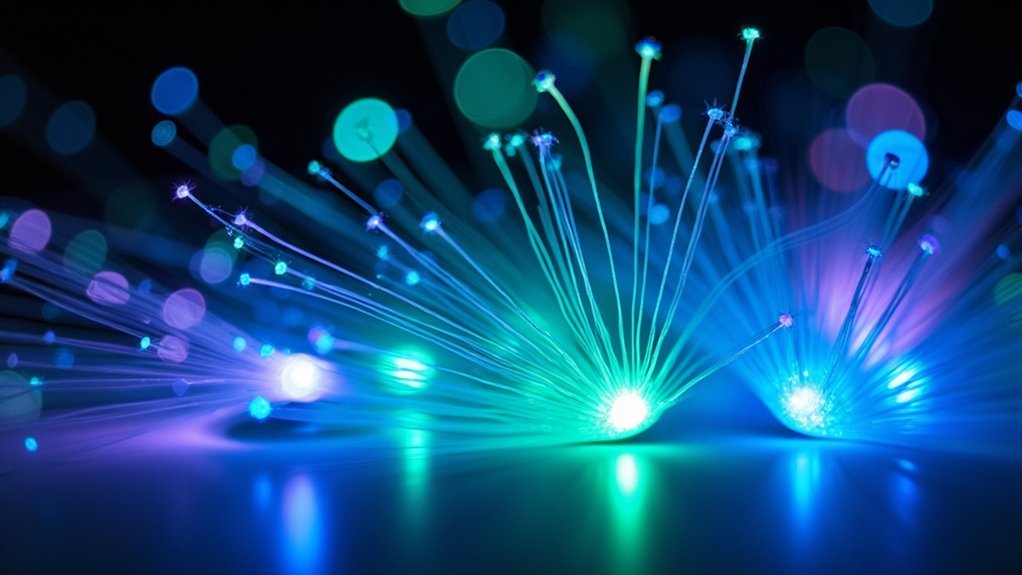
While professional fiber optic lighting systems can cost upwards of $1,000, you’ll find DIY fiber optic setups offer substantial savings without sacrificing quality.
You can assemble your own system using affordable fiber optic guides from suppliers like B&H Photo Video and Edmund Scientific, which work effectively for macro photography applications.
Many photographers have successfully created budget-friendly lighting solutions with basic components, proving you don’t need to invest in expensive brands like Broncolor or Elinchrom to achieve impressive results.
DIY Fiber Systems
Since professional fiber optic lighting systems often come with hefty price tags, many photographers have turned to DIY alternatives that deliver comparable results at a fraction of the cost.
You can source materials from retailers like Edmund Scientific and B&H Photo Video, creating custom lighting setups compatible with your existing TTL flash units.
The key to successful DIY fiber lighting is selecting the right components. Adjustable low-voltage lamps paired with appropriate fiber sizes will provide the illumination control you need for detailed macro photography.
Many photographers have ingeniously repurposed items like microscope slide covers as beam splitters to enhance their setups.
Don’t hesitate to engage with online communities where enthusiasts share their experiences and solutions. These collective insights can guide you through building an effective system without breaking the bank.
Budget-Friendly Components
Creating an affordable fiber optic lighting system doesn’t require professional-grade equipment to achieve impressive results.
You’ll find plastic or glass fiber bundles maintain transparency over time while costing considerably less than commercial alternatives.
Consider exploring microscopy suppliers for laboratory-grade fiber optic lighting components at competitive prices. Brands like Schott offer fiber optic guides around $500 with adjustable intensity and color temperature features that work perfectly with TTL flash for macro photography.
For light sources, low-voltage MR16 lamps (20-75W) or metal-halide lamps (70-250W) provide effective illumination for your DIY setup.
Community resources like the CAOS group offer valuable designs and insights for building custom systems. By leveraging these shared experiences, you’ll create professional-quality fiber optic lighting while avoiding the premium prices of high-end brands.
Seamless Integration With Microscope Setups
When you’re working with microscopy and scientific photography, proper illumination becomes critical for capturing minute details that might otherwise remain invisible.
Fiber optic lights offer remarkable compatibility with existing microscope systems, allowing you to upgrade your setup without extensive modifications.
Seamlessly integrate advanced lighting into your research toolkit without disrupting established workflows or equipment configurations.
The inherent flexibility of optical fibers enables you to position light sources at precise angles, creating ideal lighting conditions for your specimens.
You’ll appreciate how these systems can be adjusted to highlight specific structures while minimizing shadows that might obscure important details.
What’s more, fiber optic lighting generates minimal heat, protecting your delicate specimens during extended observation sessions.
With various fiber sizes and types available, you can select the perfect configuration to match your specific research requirements, ensuring exceptional light transmission and image clarity for your scientific photography projects.
Practical Applications Across Scientific Disciplines
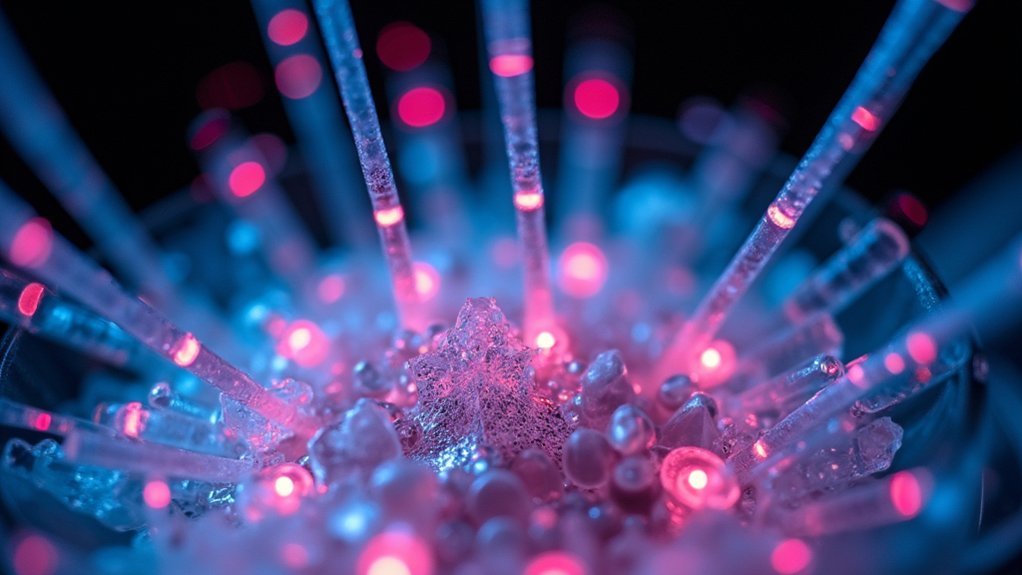
Across numerous scientific fields, fiber optic lighting systems have revolutionized how researchers capture essential visual data. In biology, you’ll find these systems illuminating microscopic cell structures without creating shadows that could obscure critical features.
Geologists rely on them to highlight mineral textures and formations with precise light control. When working with photomicrography in materials science, you can easily adjust color temperatures to reveal different structural properties.
Forensic analysts benefit from the ability to illuminate evidence from multiple angles, capturing details that might otherwise go unnoticed.
The versatility of fiber optic lighting system integration means you won’t damage heat-sensitive specimens during long exposures. Whether you’re documenting rare biological samples or analyzing crystalline structures, these systems provide the consistent, adaptable illumination needed for high-quality scientific imagery.
Frequently Asked Questions
What Are the Advantages of Using Optical Fiber?
You’ll benefit from optical fiber’s precise illumination, minimal heat production, versatile setup options, long-distance light transmission, and reduced interference. It’s ideal for capturing intricate details in various applications requiring controlled lighting.
What Is the Main Disadvantage of Fiber Optic Lighting Systems?
The main disadvantage of fiber optic lighting systems is their high initial cost. You’ll need to invest considerably upfront, which can be prohibitive if you’re working with a limited budget.
What Is the Science Behind Fiber Optics?
Fiber optics work through total internal reflection—light travels inside glass or plastic strands without escaping. When light hits the strand’s wall at an angle greater than the critical angle, it’s completely reflected inward.
What Are the Pros and Cons of Fiber Optics?
You’ll benefit from fiber optics’ precise lighting control, flexibility, and heat reduction. However, you’re facing higher initial costs and a steeper learning curve when setting up these complex lighting systems.
In Summary
You’ll achieve superior scientific photographs with fiber optic lighting systems. They’ll deliver precisely controlled illumination without damaging heat, reveal minute details, and adapt to your specific specimen needs. Whether you’re working with microscopy, macro photography, or specialized research imaging, fiber optics provide the versatility, precision, and specimen protection that digital scientific documentation demands—all while offering cost-effective alternatives to expensive professional lighting systems.

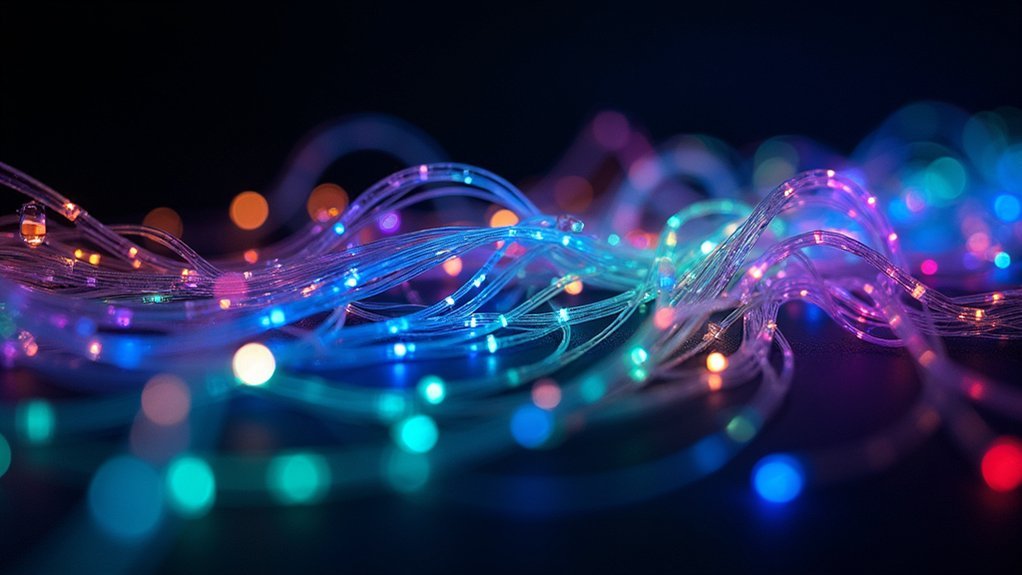



Leave a Reply